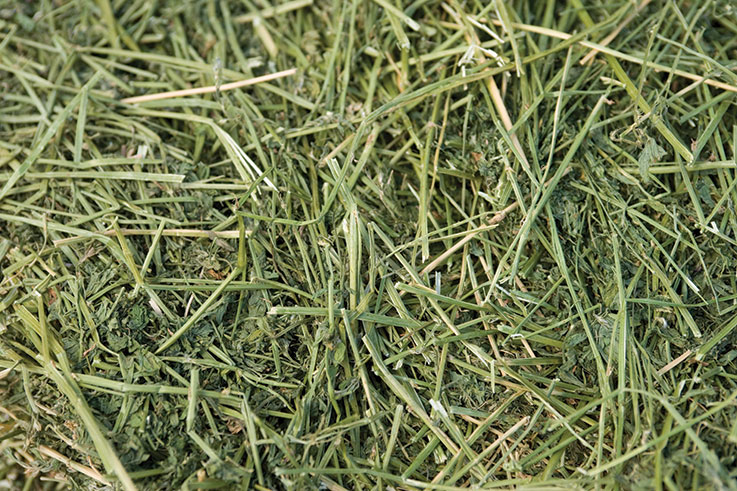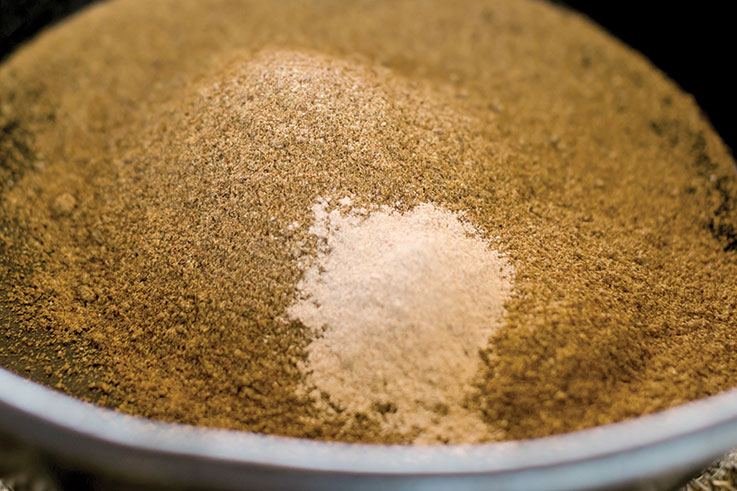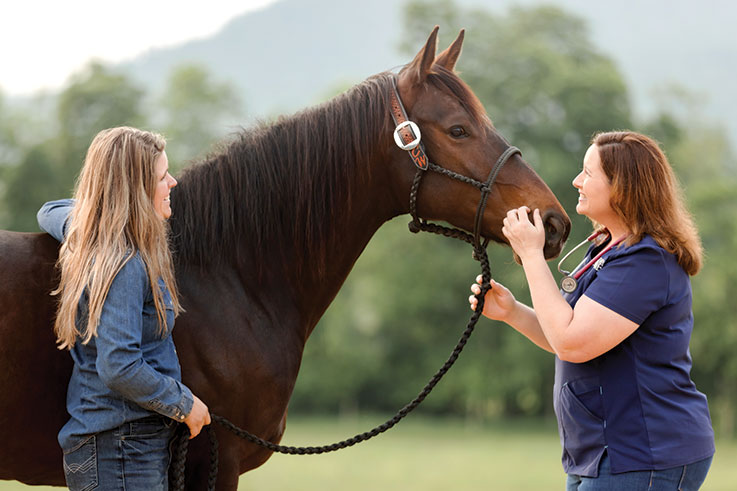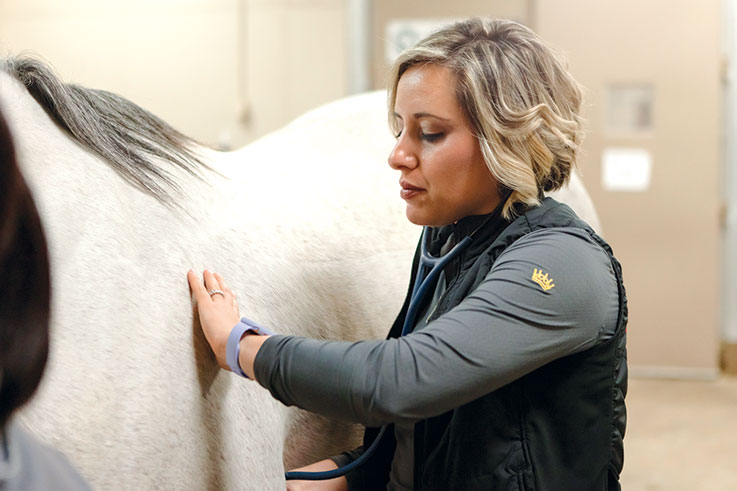Navigating Nutrition for Your Horse with Equine Metabolic Syndrome
Equine metabolic syndrome (EMS) is a significant health condition found in 18% to 27% of the equine population. It affects how horses metabolize dietary sugars and is associated with insulin resistance, generalized obesity (and/or localized fat deposits), a reduced ability to lose weight and potentially life-threatening laminitis.
In many cases, EMS is preventable. Horse owners and caretakers should be aware of the physical signs that include an overweight body condition, a cresty neck and fatty deposits by the shoulder, rump, tailhead, amongst other areas. The disorder can affect any horse but is particularly common in easy keepers and senior horses. Specific breeds with higher occurrence of EMS include Tennessee Walker, Paso Fino, Saddlebred, Morgan, Mustang, Quarter Horse, Arabians, some Warmbloods as well as donkeys, miniature horses and pony breeds. If you suspect EMS, contact your veterinarian who can diagnose the disease based on a clinical examination and tests measuring resting blood insulin levels, glucose and insulin dynamics.
EMS is treatable with proper management. Paired with exercise, the essential diet includes reducing caloric intake to maintain a healthy body condition and cutting sugar and starch content to improve insulin sensitivity.
Nutrition is a cornerstone to supporting metabolic horses and can have a profound impact on EMS. Reducing caloric intake and tweaking specific nutrients are significant steps to regaining health.
How to Feed
Nutrition is a cornerstone to supporting metabolic horses and can have a profound impact on EMS. Reducing caloric intake and tweaking specific nutrients are significant steps to regaining health. Focus on a simple, forage-based diet. Too many variables — “a pinch of this, a splash of that” — can get in the way of an effective long-term diet. The goal is a diet low in starch and sugar, regulating calories to manage weight and balancing the diet for essential vitamins, minerals and amino acids.

Feeding EMS Horses
- Analyze your hay and pasture
- Use a low-sugar (<12% NSC) hay as the foundation of the diet
- Turn out in a dry lot, or pasture turnout in the early morning with a grazing muzzle
- Eliminate grain, especially those containing oat, corn, wheat and barley
- Balance the diet with a comprehensive, low-calorie supplement
- Avoid sweet treats and significant amounts of molasses
- Provide omega-3 fats and antioxidants
- Have plain, white salt available
- Exercise (if possible)
Hay
Hay should provide the majority — if not all — the calories for a metabolic horse. It is easier to control than pasture. Know and track your horse’s body condition score and approximate weight, especially if weight reduction is needed. For overweight horses, feed 1.5% of their body weight daily and no less than 1% in long-stem forage until ideal body condition can be maintained. Weigh the hay to get an accurate amount of what is being fed. Although it may be tempting to drastically reduce hay, severely cutting back to facilitate weight loss can worsen insulin resistance. Hay consumed on a consistent availability is good for digestive well-being as well as helping blood sugar levels remain even. Slow-feeder hay nets allow horses to “graze” throughout the day while increasing the time it takes to eat their allotted amount.
A hay analysis will allow you to precisely understand what you are feeding and what supplements are needed for a balanced diet. The analysis will determine nutrient levels, including protein, minerals and calories, and can show its nonstructural carbohydrate (NSC) content. These rapidly-absorbed carbohydrates greatly affect blood glucose and insulin in EMS horses. From the hay analysis, the NSC value will equal the water-soluble carbohydrate (WSC) plus starch percentages. Hays for horses with metabolic issues should contain an NSC level of 12% or less on a dry matter basis.
If the NSC level is high, or unknown, the hay can be soaked for 30-60 minutes to remove some of the sugar content. Colder water requires a longer soak time. The soaked water containing the sugars should be discarded. Current recommendations suggest soaking for under two hours to limit the impact on total nutrient and dry matter content affected as well as lessening the potential for bacteria and mold. Feed soaked hay immediately.
Grass hay is the best place to start when organizing the diet for a metabolic horse, although hay type should be considered. Warm season grass hays, such as teff and bermudagrass, tend to naturally be low in soluble sugars. Cool season hay types, like timothy, orchard and bluegrass, have a wide spectrum of sugar contents depending on when harvested and should first be tested. Harvest times are important, as late-harvested or mature hay can have lower sugar content than a younger cut. As plants mature, sugars decrease but other nutrients may decrease as well. A vitamin/mineral supplement is suggested to meet daily nutrient requirements.
Legume hays, like alfalfa, can, often surprisingly, have a low sugar and starch content but are also higher in calories than most alternatives. Alfalfa can be used in the diet if the horse is not sensitive to it. Avoid cereal grain hays, such as oat and barley, as they may contain some seedheads that will elevate the starch level.
Hay pellets or plain, molasses-free beet pulp can be mixed with supplements. Beet pulp contains high non-fiber carbohydrates, which are mostly pectin, a soluble fiber. It also has one of the lowest glycemic indices of common feeds — even lower than most grass hays. The glycemic index of a feed describes the level of glucose absorbed into the bloodstream after consumption. With insulin resistant horses, it is best to avoid sugar spikes.
EMS Hay Analysis: Feeding Horses Carbohydrates
- Non-structural carbohydrates (NSC): Plant cell parts that are hydrolyzable or rapidly fermentable.
- Water soluble carbohydrates (WSC): Soluble in water or GI fluid. Monosaccharides (Glucose, Fructose) + Disaccharides (Sucrose) + Oligosaccharides + Fructan.
- Ethanol soluble carbohydrates (ESC): Subfraction of WSC, Glucose + Fructose + Sucrose.
- Starch: Long chains of sugar molecules linked together. Starch digestion results in glucose and consequently elevated insulin. Cereal grains, including oats, corn and barley, are very high in starch.
- Fructan: Causes insulin to spike in EMS horses. High levels can lead to laminitis from fermentation by hindgut bacteria.
On the Hay Analysis, NSC = WSC + Starch %
For EMS horses, aim for an NSC value of less than 12% on a dry matter basis.
If higher, soak hay for 30 to 60 minutes; the colder the water, the more soaking time required, up to two hours.
Pasture
Typically an excellent forage choice, pasture intake can be difficult to manage for metabolic horses and should be used with caution or not at all. Forage testing is recommended as sugar and starch levels can vary widely between seasons, months and even within the same day. The pasture grazing time with the lowest sugar and starch levels is the early morning hours when the night temperatures are above 40 degrees. Grass sugars increase with exposure to sunlight with levels peaking in the late afternoon. These sugars are used as fuel by the grass during the dark with the lowest levels occurring in the early morning. Stressors, such as drought, cold weather, overgrazing or short mowing, force grasses to preserve sugar content for self-preservation, which will increase NSC levels. For horses on pasture, consider a grazing muzzle that will allow a horse to graze while consuming fewer total calories and less sugar.
Did You Know?
The pasture grazing time with the lowest sugar and starch levels is the early morning hours when the night temperatures are above 40 degrees.

Emily Robertson and her Belgian Draft-Arabian is known around the barn as Barney.
Grain
Cereal grains should not be fed to a horse with EMS. Oats, corn, barley and other grains are high in starch, which break down to glucose and elevate insulin. Some commercial concentrates (textured or pelleted feed) advertised as low-starch may actually have a combined sugar and starch level from 13-30% — too high to feed to a metabolic horse. Refrain from giving treats, even healthy ones, until a normal weight is achieved.
Animals on a restricted diet may be at risk for vitamin and mineral deficiencies. A comprehensive supplement that provides omega-3 fatty acids, antioxidants, vitamins and trace minerals can complement a forage-based diet.
Supplements
Animals on a restricted diet may be at risk for vitamin and mineral deficiencies. EMS is associated with inflammation and oxidative stress. Supplements are recommended to support cellular health. A comprehensive supplement that provides omega-3 fatty acids, antioxidants, vitamins and trace minerals can complement a forage-based diet and support a healthy metabolism with minimal calories. Omega-3 fatty acids provide many health benefits for metabolic horses including helping maintain normal levels of inflammation. Vitamin E is an antioxidant that scavenges free radicals and reduces oxidative stress. Magnesium, commonly deficient in equine diets, supports healthy glucose metabolism by supporting the cellular response to insulin. Chromium is involved in normal carbohydrate and fat metabolism and supports the uptake of glucose from the blood into muscle tissue or fat storage. Carnitine may support a healthy weight as it plays a role in sugar and fat metabolism at the cellular level. And plain, white salt should always be available to provide sodium chloride and support healthy hydration, along with fresh, clean water.

Supplementing for Metabolic Health
- Omega-3 fatty acids provide many health benefits for metabolic horses, including helping maintain normal levels of inflammation.
- Vitamin E is an antioxidant that scavenges free radicals and reduces oxidative stress.
- Magnesium, a commonly-deficient mineral in equine diets, supports healthy glucose metabolism by supporting the cellular response to insulin.
- Chromium is involved in normal carbohydrate and fat metabolism and supports the uptake of glucose from the blood into muscle tissue or fat storage.
EMS Big 3: Insulin Resistance, Obesity and Laminitis
1. Insulin Resistance
Insulin resistance (IR) contributes to several health conditions. It is implicated in obesity, equine metabolic syndrome, laminitis, hyperlipidemia, colic and pituitary pars intermedia dysfunction (PPID or equine Cushing’s disease) and osteochondrosis in foals from obese mares. While not every horse with insulin resistance has EMS, every EMS horse is insulin resistant. A horse has IR when body tissues have a decreased responsiveness to the hormone insulin compared to unaffected horses. The impairment affects carbohydrate metabolism, especially glucose (blood sugar). When a horse eats a meal, glucose rises in response to the digestion of sugar and starch in the small intestine. Glucose exits the small intestine and enters the blood stream to be metabolized for energy in the cells throughout the body. There are receptors on the cell surfaces, and insulin unlocks each receptor to allow glucose to enter the cell. In the pancreas, beta cells secrete insulin into the blood stream in response to a rise in glucose to move the blood sugar into the cells to be used for energy (or stored). In horses with IR, more insulin is needed to move glucose because the cells are “resistant” to this uptake. Specifically, cells in muscle, adipose tissue and the liver that become insulin resistant require larger concentrations of circulating insulin to stimulate glucose uptake: They are less sensitive to insulin. An IR horse produces more units of insulin per unit of blood sugar than a normal horse, and insulin concentrations in the blood are higher in IR horses as it takes longer to clear blood glucose, particularly after a high-carbohydrate meal. IR horses may have normal resting blood glucose but can also experience abnormal spikes in blood insulin (hyperinsulinemia), a risk factor for laminitis, after meals.
There are two subtypes of IR. Uncompensated IR is rare but can be seen with advanced stages of PPID. In this form, the pancreatic beta cells are overworked for too long and eventually fail, causing blood glucose levels to stay elevated. Compensated IR — the most common risk factor for laminitis — occurs when the pancreas is actually functioning normally. However, insulin levels will be elevated (hyperinsulinemia) with blood glucose levels eventually returning to normal.
Prolonged intake of high grain or sweet feeds can lead to weight gain and impaired insulin sensitivity. Elevated insulin causes the body to store more fat, and excess fat causes a decrease in insulin receptors on the cell — a vicious cycle. Diets for IR horses aim to reduce dietary sugar and starch that will lessen circulating blood glucose and decrease insulin output necessary from the pancreas. A typical recommendation is to use a low-NSC hay and avoid concentrated feed, especially in an overweight horse. Use a balanced supplement for essential vitamins and minerals that may be lacking from a hay-only diet.
Are Horses with EMS and Cushing’s Fed the Same Way?
EMS and pituitary pars intermedia dysfunction (PPID), or equine Cushing’s disease, have several overlapping symptoms, but their etiology is dramatically different. They can occur independent of one another. Older horses are more likely to develop PPID; however, young horses can develop it as well. Outward signs of Cushing’s can include: a long, coarse, wavy hair coat; abnormal shedding; loss of muscle mass; a noticeable increase in thirst and urination; ulcers in the mouth; and a decrease in immune system function.
In PPID, there is a hormone-secreting tumor in the pars intermedia portion of the pituitary gland. The tumor is thought to create pressure on the hypothalamus of the brain resulting in a reduction in function. The pars intermedia releases excessive amounts of adrenocorticotropic hormone (ACTH). ACTH (typically measured to diagnose PPID) stimulates the adrenal gland to produce cortisol. Resting ACTH levels are often high in horses with PPID and fluctuate seasonally. Elevated ACTH causes the adrenals to produce higher than normal levels of cortisol. While cortisol has normal functions in the body, typically at low levels, excessive sustained elevations of cortisol can cause tissues to become insulin resistant. As a result, insulin levels rise in the bloodstream, which can result in laminitis. Horses over 20 years old have lower insulin sensitivity compared to younger, mature horses. PPID and IR often occur together. Laminitis can be a result of PPID, as it can for EMS.
Horses with PPID can have different body conditions, and it is important to treat them nutritionally as individuals. If they have Cushing’s, are overweight and struggle with insulin resistance, they will be fed similar to a horse with EMS. If they have a low body condition score (BCS), need weight gain and have insulin resistance, they will require a specific diet: low in starch and sugar but a higher amount of calories to help achieve a healthy BCS. Quality hay free choice, including alfalfa, true low-starch feeds and healthy fats and oils are suggested.

Dr. Maggie Loomer, of PenMar Equine, with her client Cecilia.

Dr. Rachel Liepman evaluates a patient.
2. Obesity
Obesity, an abnormal or excessive fat accumulation that may impair health, is estimated to affect 20% to 40% of domesticated horses. Horses today often consume energy-rich foods that provide calories greater than what their metabolic rate can burn through, leading to weight gain and obesity. Genetics also influence weight gain as well as metabolic rate, and many easy-keeping breeds have a genetic tendency for obesity.
Adipose (fat) is a living, metabolically active tissue and not totally benign. Abnormal amounts produce cytokines and other mediators, like cortisol, that promote inflammation throughout the body, including the hooves, and may be a factor in laminitis. Inflammation from adipose tissue may be central to the link between obesity and insulin resistance. Due to its association with equine morbidity and mortality, obesity is becoming more recognized as a welfare concern. Reducing body condition can reduce inflammation throughout the horse’s body. The Henneke Body Condition Scoring system is very useful for assessing a horse’s body condition score, or BCS. The ideal BCS is in the 4-6 range (on a 1-9 scale). A BCS greater than 6 is considered overweight, and a BCS of 7 or higher is obese. It is important to know a horse’s BCS to better manage and make dietary adjustments to remain at an ideal body condition for health and longevity.
Obesity is also associated with insulin resistance. Not all obese horses are insulin resistant, however; and insulin resistance can occur in the non-obese horses too. Obese horses and ponies have lower insulin sensitivity when compared to their lean and moderately conditioned counterparts. Obesity as it pertains to IR elevates insulin, causing the body to store more fat. Excess fat causes a reduction in insulin receptors on the cell membrane, leading to the production of more insulin. This is why most EMS horses develop the regional adiposity (in the neck, tailhead and along the spine); the more fat that is produced, the higher the insulin levels become as the cells resistant to insulin have trouble regulating glucose.
Too many calories, a diet heavy in carbohydrates and sugars, as well as a lack of exercise are all linked to obesity. Fortunately, obesity can be addressed through diet and exercise, although a lifestyle change is needed. Reducing weight in an obese horse increases insulin sensitivity. Horses are meant to thrive on forage, and most modern horses do not need the cereal grains or high-calorie concentrates that are a mainstay of most current feeding programs. Cutting concentrates and focusing on a forage-based or all-forage diet can support the return to a healthy weight. Exercise supports insulin sensitivity directly as well, helping to maintain healthy blood glucose and insulin levels. Exercise can increase the numbers of insulin receptors within cell membranes, allowing for improved glucose cell access. More receptors reduce the need for more insulin, and less insulin results in less fat storage. Even small amounts of exercise support insulin sensitivity. If not dealing with laminitis or a painful horse, aim for 30 minutes of daily exercise. If the horse is unfit, start at a walk with little trot intervals and work up to longer trotting time and then canter work. If riding the horse is not an option, try to hand walk, lunge, use a roundpen or turn the horse out in an indoor arena to increase movement.
Metabolic Vocabulary
Horse owners who have dealt with a metabolic horse may have been confronted with a crash course in endocrinology. The different words and phrases that refer to metabolic issues can be confusing and often overwhelming, let alone how they all interact with each other. Below are common terms that may be heard when discussing equine metabolic syndrome.
- Equine Metabolic Syndrome (EMS): A collection of endocrine and metabolic abnormalities including the presentation of obesity, insulin resistance and laminitis or a predisposition to laminitis in horses, ponies and donkeys.
- Glucose: The main sugar found in the bloodstream, and the body’s primary energy source.
- Insulin: A hormone produced by the pancreas that controls the amount of glucose in the bloodstream. It also helps store glucose in liver, fat and muscle tissue. Insulin regulates the body's metabolism of carbohydrates, fats and proteins.
- Hyperinsulinemia: The amount of insulin in the blood is higher than what is considered normal or healthy. Hyperinsulinemia is caused by increased insulin secretion or delayed glucose clearance, and may be a problem caused by or a consequence of insulin resistance.
- Insulin Resistance (IR): The failure of insulin-sensitive tissues to respond to insulin, characterized by hyperinsulinemia.
- Insulin Dysregulation (ID): A collective term to describe abnormalities of insulin metabolism including excessive insulin responses to sugars, fasting hyperinsulinemia and insulin resistance, components of EMS.
- Leptin: A chemical messenger triggered by feed intake that helps control appetite and promotes activity to maintain body condition.
3. Laminitis
Horses with EMS are at risk for developing laminitis — a dreaded and potentially deadly diagnosis. Laminitis is inflammation of the laminae, the connective anchor tissue between the hoof wall and coffin bone within the hoof capsule. The laminae consist of complex, intricately folded tissue layers, which attach the coffin bone to the hoof capsule. When compromised from inflammation and are weakened, damaged or die, the hoof portion of the laminae can release from the rest of the hoof and the coffin bone portion, allowing separation made worse by the deep digital flexor tendon at the back of the leg. Laminitis that progresses to the rotation and sinking of the coffin bone through the bottom of the foot is also called founder. It can be an extremely painful and crippling disease. Laminitis can affect all four limbs but is typically worse in the front feet.
Laminitis can be a chronic issue that develops over time, or it can be acute with a sudden onset. There are several reported causes including: grain or carbohydrate overload; abrupt changes in the diet; access to pasture high in sugars (especially fructans); elevated fever or illness; ingestion of toxic plants; bedding containing black walnut shavings; excessive concussion to the feet (road founder); compensatory weight bearing due to injury of the opposite leg (supporting-limb laminitis); and sensitivity to steroids, which is exaggerated in EMS horses. Laminitis can also result from diseases such as PPID and EMS.
Tissues can be damaged by inflammation and the abnormal metabolic and hormonal states due to EMS. The common components of EMS that include obesity, insulin dysregulation, hyperinsulinemia, hyperleptinemia (elevated leptin) and hypertriglyceridemia (elevated triglycerides) are all risk factors for laminitis. Elevated blood insulin is a common and significant factor in many cases of laminitis. Insulin has vasoregulatory actions. IR can actually promote vasoconstriction with less blood reaching this important hoof tissue. Inappropriate glucose and insulin levels may impair glucose uptake of the laminar cells. While the exact mechanism still remains unknown, it is possible that glucose deprivation in keratinocytes (hoof cells) can lead to weakened laminar attachment and laminitis.
You May Also Like


Laminitis in Horses
How skilled veterinarians and farriers are propelling the prevention and treatment of laminitis forward for the horse.
Read More
Sugar Rush: The Rise in Equine Metabolic Conditions
Veterinarians are seeing an up-tick in metabolic-related issues; Luckily most are treatable and largely preventable
Read More
